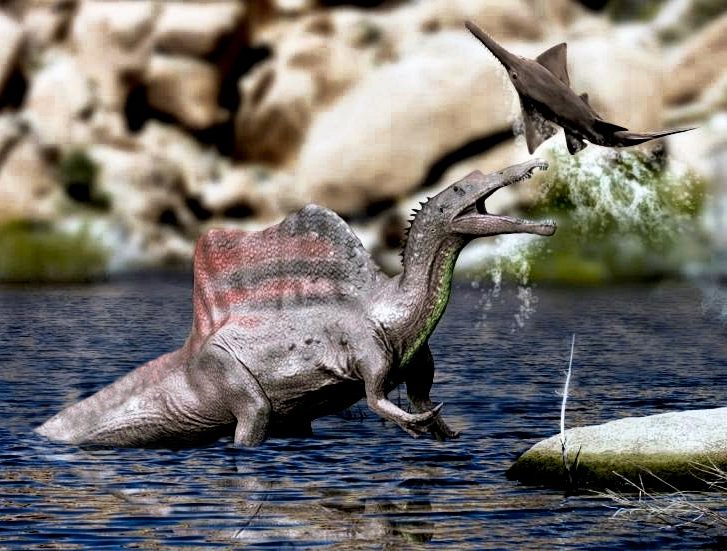In the world of paleontology, few discoveries have shattered long-held assumptions quite like Yutyrannus huali. This massive feathered predator from Early Cretaceous China fundamentally altered our understanding of tyrannosaurs and challenged the traditional image of Tyrannosaurus rex and its relatives. Unveiled to the scientific community in 2012, Yutyrannus—whose name translates to “feathered tyrant”—provided conclusive evidence that even large theropod dinosaurs could sport extensive feathery coverings. At approximately 9 meters (30 feet) long and weighing around 1.5 tons, this creature forced paleontologists to reconsider their depictions of T. rex and revolutionized public perception of these ancient predators. Let’s explore this remarkable dinosaur and its profound impact on dinosaur science.
The Groundbreaking Discovery

The story of Yutyrannus begins in the Yixian Formation of Liaoning Province, China, where three remarkably preserved specimens were unearthed in 2009. What made these fossils extraordinary wasn’t just their completeness but the unmistakable evidence of filamentous feathers preserved alongside the skeletal remains. The specimens included one adult and two juveniles, providing paleontologists with a rare opportunity to study growth stages within the same species. Chinese paleontologist Xu Xing and his team made the formal description in 2012, publishing their findings in the prestigious journal Nature. This discovery sent shockwaves through the scientific community precisely because Yutyrannus was not a small, bird-like dinosaur as most previously known feathered specimens had been, but a massive predator that upended expectations about which dinosaurs could have feathers.
Anatomy of a Feathered Giant
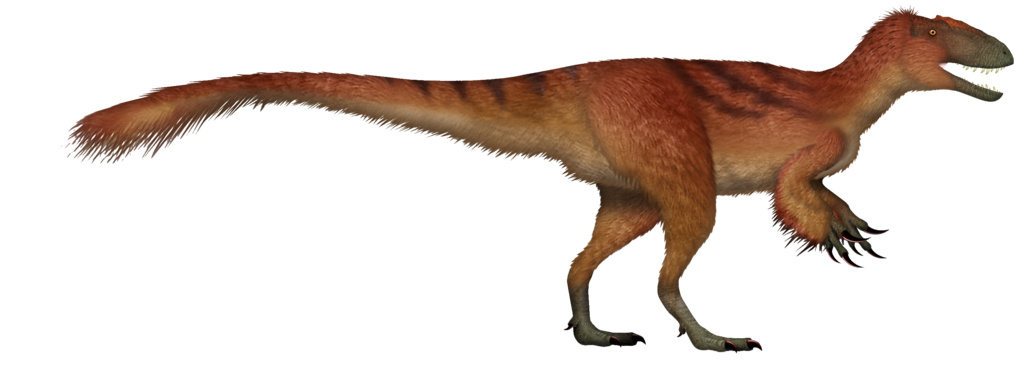
Yutyrannus displayed the classic tyrannosaur body plan with several distinctive features that set it apart from later relatives like T. rex. It possessed a large skull adorned with a prominent crest running along the top of its snout, giving it a distinctively ornate appearance. The arms of Yutyrannus were proportionally longer than those of T. rex, suggesting they retained more functionality than the famously reduced forelimbs of later tyrannosaurs. Its powerful hindlimbs and robust build indicate it was an active predator capable of pursuing prey across the Early Cretaceous landscapes. Most significantly, the preserved integumentary structures—its feathers—appeared as filamentous impressions up to 20 centimeters long, covering significant portions of the body including the tail, neck, and limbs, forming what scientists describe as a shaggy, primitive feather coat rather than the more complex feathers seen in modern birds.
The Feather Revolution

The feathers of Yutyrannus represented a pivotal discovery in dinosaur paleontology. Before this finding, scientists had documented feathers on numerous small theropod dinosaurs, particularly those closely related to birds, but the prevailing theory suggested large dinosaurs like tyrannosaurs would have lost feathers as an adaptation to prevent overheating. Yutyrannus shattered this assumption. The structures preserved with Yutyrannus weren’t advanced contour or flight feathers, but rather simple filamentous proto-feathers that likely formed a shaggy coat across much of its body. These structures would have served for insulation rather than flight, similar to how modern flightless birds like emus retain feathers for temperature regulation. The presence of these feathers on such a large predator forced scientists to reconsider whether even T. rex itself might have sported some degree of feathery covering, especially during juvenile stages or in cooler climates.
Evolutionary Position: The Tyrannosaur Family Tree

Yutyrannus occupies a fascinating position in the tyrannosaur evolutionary tree, representing a transitional form between earlier, more primitive tyrannosaurs and the advanced forms that would eventually culminate in T. rex. Dating to approximately 125 million years ago during the Early Cretaceous period, Yutyrannus existed roughly 59 million years before T. rex appeared on the scene. Phylogenetic analyses place it as a member of the tyrannosauroid superfamily but outside the more derived tyrannosaurids that include T. rex. This positioning makes Yutyrannus especially valuable for understanding tyrannosaur evolution. It demonstrates that large size evolved relatively early in tyrannosaur history, well before the famous giants of the Late Cretaceous, and provides evidence that the ancestral condition for all tyrannosaurs likely included some form of feathery covering. Consequently, Yutyrannus serves as a crucial missing link in tyrannosaur development, showing an intermediate stage in the evolution of these iconic predators.
Life in Early Cretaceous China

During Yutyrannus’s time, approximately 125 million years ago, the ecosystem of what is now Liaoning Province in northeastern China was dramatically different from today. The region featured a temperate forest environment with numerous lakes and streams, creating a lush landscape teeming with diverse wildlife. Volcanic activity periodically blanketed the area in ash, which—while devastating to the inhabitants—created the perfect conditions for exceptional fossil preservation. Yutyrannus shared this ancient world with a variety of other dinosaurs, including the smaller feathered dinosaur Beipiaosaurus, the early tyrannosaur Dilong, and numerous avian dinosaurs. The climate was notably cooler than other Cretaceous environments, with average temperatures estimated at about 10°C (50°F), which may explain why Yutyrannus retained an extensive feather covering despite its large size. These cooler conditions would have made insulation beneficial even for a large predator, supporting the hypothesis that its feathers served primarily for temperature regulation.
Hunting and Feeding Behavior
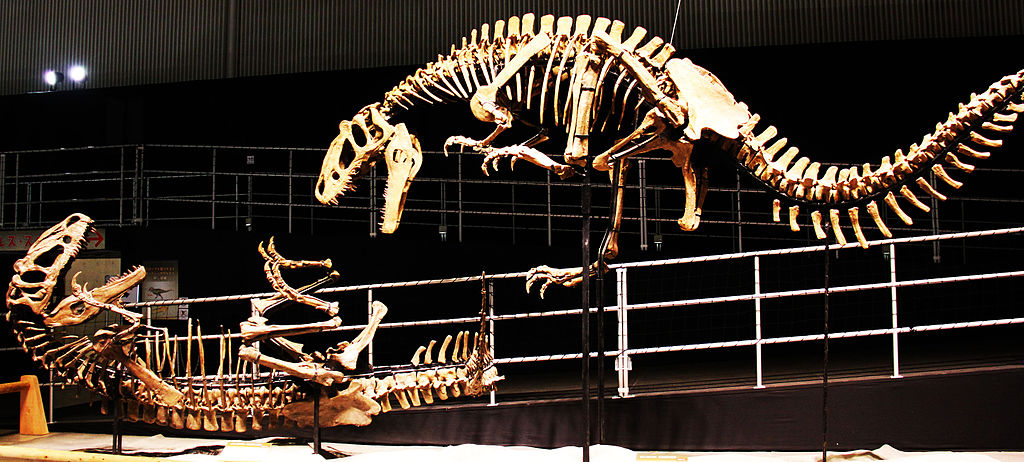
As the apex predator in its ecosystem, Yutyrannus would have been a formidable hunter equipped with adaptations specialized for taking down prey. Its skull structure, featuring powerful jaw muscles and teeth designed for puncturing and gripping, suggests it employed a bite-and-hold strategy similar to other tyrannosaurs. Unlike the bone-crushing capabilities of T. rex, Yutyrannus likely had a somewhat weaker bite force more suited to dispatching the smaller prey animals available in its environment. Analysis of the Yixian Formation ecosystem suggests potential prey would have included the abundant plant-eating dinosaurs like Psittacosaurus and various ornithopods. Yutyrannus likely hunted using a combination of ambush and pursuit tactics, with its relatively long arms potentially playing a more active role in prey capture than the reduced limbs of later tyrannosaurs. Some paleontologists have proposed that Yutyrannus may have engaged in pack hunting based on the discovery of multiple specimens in close proximity, though this remains speculative without more definitive evidence of social behavior.
The Function of Feathers in a Giant Predator

The presence of extensive feathering on a dinosaur as large as Yutyrannus raises fascinating questions about the purpose these structures served. The most widely accepted hypothesis is that Yutyrannus’s feathers primarily functioned as insulation. The relatively cool climate of Early Cretaceous Liaoning would have made temperature regulation crucial, and even a large animal would benefit from additional insulation during colder seasons. Alternative theories suggest the feathers may have served display functions during courtship or territorial disputes, with the possibility that they contained pigments creating patterns or colors that have not preserved in the fossil record. Some researchers have proposed that juvenile Yutyrannus might have used their feathers differently than adults, potentially for camouflage while hiding from larger predators or even other adult Yutyrannus. The extensive feather covering might also have helped females regulate nest temperature while brooding eggs, assuming Yutyrannus exhibited parental care behaviors similar to those documented in some other theropod dinosaurs.
Rewriting the Tyrannosaur Narrative
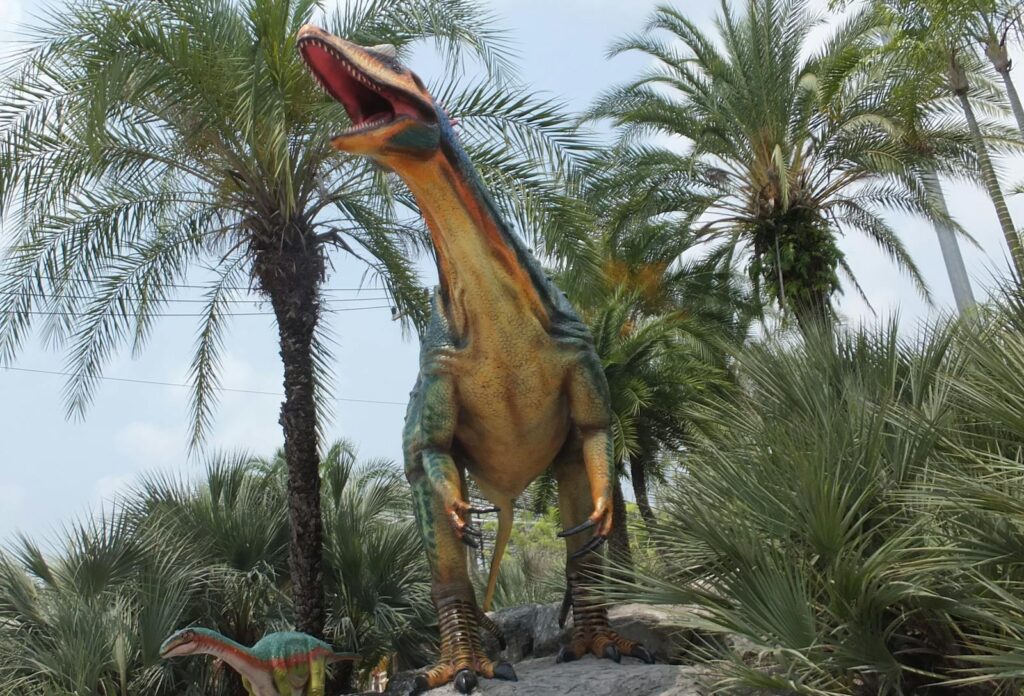
Prior to the discovery of Yutyrannus, the popular and scientific understanding of tyrannosaurs was dominated by the image of T. rex as portrayed in films and museums: a terrifying scaled predator resembling an oversized lizard. Yutyrannus fundamentally transformed this narrative, demonstrating that at least some large tyrannosaurs possessed feathers and suggesting the possibility that even T. rex itself might have had some feathery covering, especially during juvenile stages. This revelation forced museums worldwide to update their exhibits and reconsider decades of tyrannosaur depictions. The impact extended beyond just tyrannosaurs to challenge assumptions about other large theropods, sparking debates about whether Allosaurus, Spinosaurus, and other massive predatory dinosaurs might have sported similar integumentary structures. Yutyrannus has become the poster child for the modern understanding of dinosaurs as dynamic, birdlike creatures rather than the slow, cold-blooded reptiles of outdated paleontology.
Did T. rex Have Feathers Too?
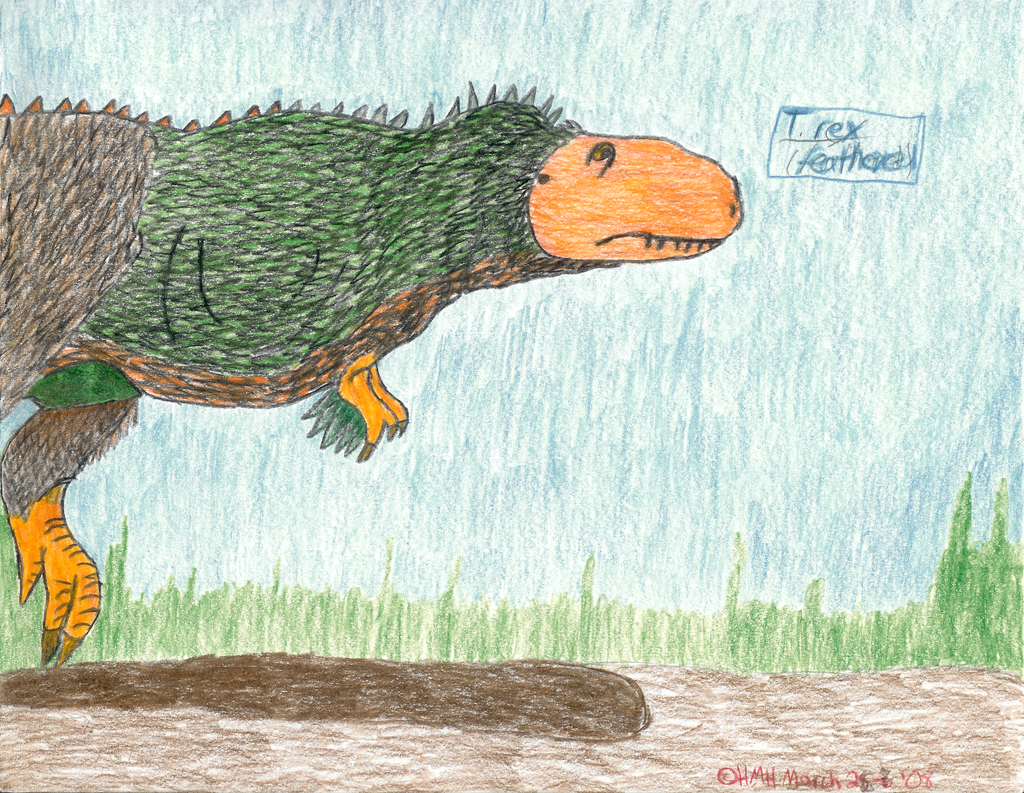
The discovery of feathers on Yutyrannus inevitably raises the question: did Tyrannosaurus rex have feathers as well? This remains one of the most hotly debated topics in dinosaur paleontology. Some skin impressions from T. rex and its close relatives show pebbly scales similar to those of modern reptiles, suggesting at least parts of their bodies lacked feathers. However, these samples represent only small portions of the animal’s total skin surface. Given that Yutyrannus demonstrates feathers were present in the tyrannosaur lineage, many paleontologists consider it plausible that T. rex retained some feathery covering, particularly as juveniles or in specific body regions. The climate of Late Cretaceous North America was generally warmer than Early Cretaceous China, potentially reducing the need for insulating feathers in adult T. rex. A growing consensus suggests T. rex may have had a complex integument with different coverings on different body parts—perhaps feathered as juveniles and partially feathered as adults, with feathers concentrated on the back and tail while other areas displayed scales.
The Science of Reconstructing Ancient Animals

The discovery of Yutyrannus highlights the challenging nature of accurately reconstructing extinct animals. Paleontologists must piece together these creatures using incomplete evidence, often working with fragmentary fossils that provide only partial glimpses into an animal’s appearance and biology. Soft tissues rarely preserve, making structures like feathers, skin, and internal organs difficult to determine without exceptional preservation conditions. The fossil record is inherently biased toward preserving hard structures like bones and teeth, creating significant gaps in our understanding of soft tissue anatomy. This limitation explains why the discovery of feather impressions with Yutyrannus was so revolutionary—it provided direct evidence of soft tissue features that would otherwise remain speculative. Modern paleontologists increasingly employ comparative anatomy with living relatives (birds and crocodilians for dinosaurs), biomechanical modeling, and advanced imaging techniques to develop more accurate reconstructions. The dramatic revision of Yutyrannus and potentially other tyrannosaurs demonstrates how one exceptional fossil can transform decades of scientific understanding.
The Liaoning Fossil Beds: A Window to the Dinosaur World

The remarkable preservation of Yutyrannus would not have been possible without the exceptional conditions of the Liaoning fossil beds in northeastern China. These deposits represent one of paleontology’s greatest treasure troves, preserving thousands of specimens with extraordinary detail, including soft tissues, feathers, skin impressions, and even original color patterns in some cases. The unique preservation results from fine volcanic ash that rapidly buried organisms following eruptions, creating conditions that prevented decay and allowed mineralization of delicate structures. Beyond Yutyrannus, these formations have yielded numerous groundbreaking fossils including Microraptor (a four-winged dinosaur), Psittacosaurus (with preserved coloration), and some of the earliest known true birds with feathers intact. The Yixian Formation specifically has produced a nearly complete ecosystem snapshot from the Early Cretaceous, allowing scientists to understand not just individual species but their environmental context and ecological relationships. Without these exceptional preservation conditions, our understanding of feathered dinosaurs—including Yutyrannus—would be drastically more limited.
Popular Culture Impact: Changing the Public Perception
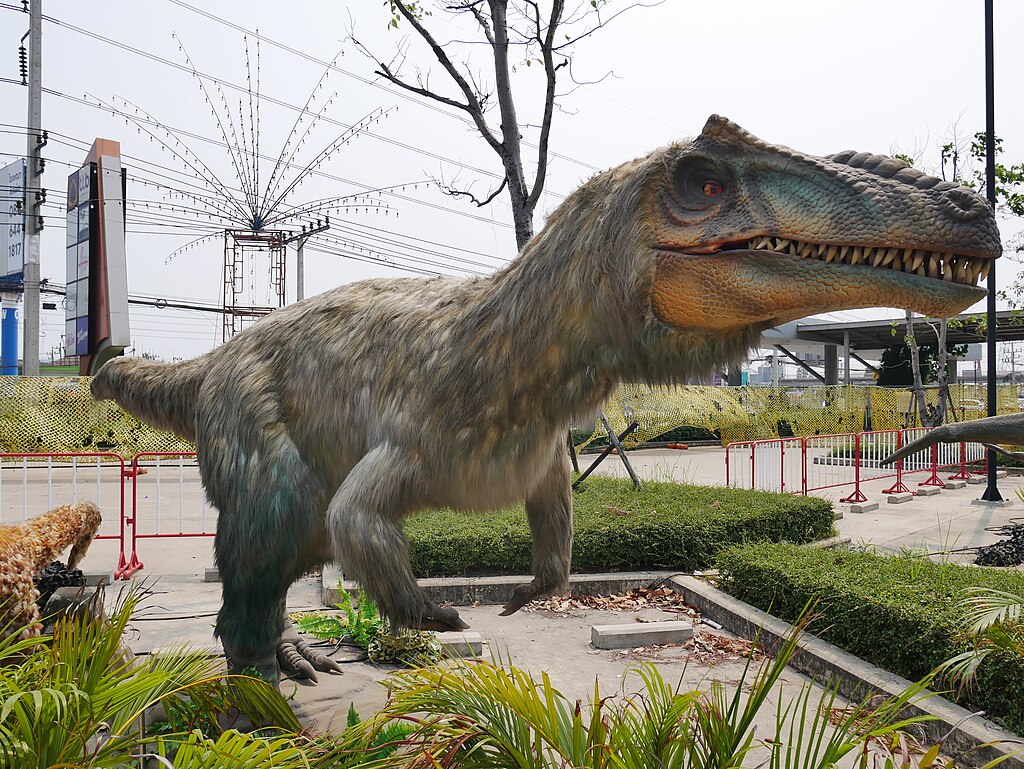
The revelation of Yutyrannus as a feathered giant has dramatically influenced how dinosaurs are portrayed in popular media, gradually reshaping public perception of these ancient creatures. Following its discovery, museums worldwide began updating their tyrannosaur displays, incorporating feathers into reconstructions and reflecting the latest scientific understanding. The impact extended to documentary series like BBC’s “Planet Dinosaur,” which featured Yutyrannus with its feathery covering, helping educate audiences about this revolutionary finding. Even Hollywood has begun incorporating feathered dinosaurs, though more slowly and inconsistently, with films like “Jurassic World” acknowledging the science but largely maintaining the scalier versions for continuity and audience expectations. Children’s books, educational materials, and toys increasingly depict feathered tyrannosaurs, ensuring the next generation grows up with a more scientifically accurate understanding. The transition has not been without controversy, with some resisting the new feathered image of beloved dinosaurs, demonstrating how deeply entrenched the traditional scaly depiction had become in cultural consciousness.
Future Research Directions

The discovery of Yutyrannus has opened numerous avenues for future research that continue to drive paleontological inquiry. Scientists are particularly interested in finding additional specimens that might preserve feathers with enough detail to determine color patterns or more specific feather types, which could provide insights into display behaviors and ecological adaptations. The question of feathered versus scaled integument in other large theropods remains contentious, spurring expeditions targeting formations that might preserve exceptional soft tissue evidence. Researchers continue investigating the thermoregulatory implications of feathers on large dinosaurs, using computer modeling to understand how these structures affected body temperature in different climates. Biomechanical studies examining Yutyrannus’s locomotion and hunting capabilities seek to determine how its feathered body plan might have influenced its predatory behavior compared to later tyrannosaurs. Perhaps most intriguingly, the search continues for evidence that might definitively resolve whether T. rex itself had feathers, with paleontologists closely examining new and existing specimens for previously overlooked integumentary impressions that could finally settle this captivating question.
Conclusion

The discovery of Yutyrannus represents one of the most significant paradigm shifts in modern paleontology, forever changing our understanding of tyrannosaurs and other large theropod dinosaurs. By providing conclusive evidence that even giant predatory dinosaurs could sport extensive feathery coverings, Yutyrannus forced scientists to reconsider decades of assumptions about dinosaur appearance, physiology, and evolution. This remarkable creature bridges crucial gaps in our understanding of tyrannosaur development and offers a tantalizing glimpse of what T. rex itself might have looked like. As our knowledge continues to evolve, Yutyrannus stands as a powerful reminder that even in well-studied groups like dinosaurs, groundbreaking discoveries can completely transform scientific understanding. The feathered tyrant from China hasn’t just changed what we know about T. rex—it has fundamentally altered how we envision the ancient world of dinosaurs.

